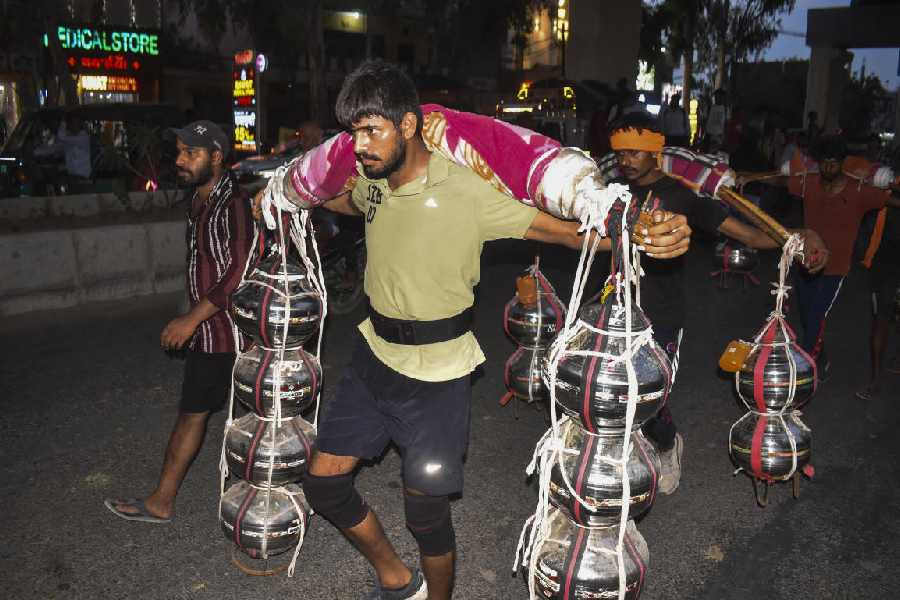 |
| On the Rocks at the Sheraton Park Hotel & Tower, Chennai, offers an assortment of meats cooked by guests on hot lava rocks right at their tables; (below) every guest cooks the meat over a rock which is pre-heated in a special oven for some four hours |
 |
Culinary bravehearts, brace yourself for the ultimate challenge. At San-Qi, the Asian fine dining restaurant at Four Seasons Hotel, Mumbai, there’s a pristine white platter laid out for you with paper thin slivers of fugu or blowfish presented as elaborate, yet delicate, rosettes. The piscine extravaganza comes with piquant soy, chive and an exotic bitter orange relish as dipping sauces.
But there’s a Big catch (in more ways than one). A whole fugu has enough tetrodotoxin (a deadly variety of poison) to kill up to 30 people in a matter of seconds. And yes, there’s no currently known antidote to this toxin.
“The chances of death are as high as 90 per cent if the fish is caught and cooked by a layman,” says chef Kato, Four Seasons’ licensed fugu chef, whose training involved identifying blowfish species, their distinctive anatomy, relative toxicity of the body parts, methods of disembowelling and cleaning, instructions for preparation — and above all, first aid procedures in the event of a culinary disaster. The exotic four-piece fugu sushi platter will cost you around Rs 1,000.
Say hello to the new world of quirky gastronomy where edgy ingredients, one-of-their-kind dining experiences and innovative food presentations are the order of the day. Aided by an army of experimental chefs and cutting-edge hospitality entrepreneurs, the adventurous foodie is finding his place under the sun as interesting dining styles make their way to high-octane restaurants.
Another pit stop in the foodie’s itinerary is the Olive Bar & Kitchen in the Capital where diners pound their own salsa in stone mortars and pestles. So in go baby onions, oven roasted tomatoes, garlic pods, olive oil, fresh rosemary and basil for your-own-kind-of fragrant salsa to be smeared on bread that’s individually baked in traditional cast iron skillets for each guest. There’s never a dull moment at Olive. “We have a new Tuscan kitchen here, in an enclosed space called Greenhouse on the Ridge, overlooking the forest, where you can spend an evening with your loved ones as our chef cooks right around you,” says restaurateur A. D. Singh, the man behind Olive Bar & Kitchen and contemporary Japanese restaurant, Ai.
“For seasoning the salsa, we place the Ferrari of salts — Maldon — on the table. These are flaky salt crystals that impart a unique flavour to the food,” adds chef Saby, the man wielding the spatula at Olive Bar & Kitchen and Ai.
 |
| At the Induction Table at Radisson MBD, Noida, you can help to rustle up an elaborate spread with a bit of help from the resident chef Pix by Jagan Negi |
Next up is The Yum Yum Tree, that’s redefining the culinary code for Chinese restaurants. The outlet dishes out contemporary Chinese cuisine and Oriental street food and even offers diners the luxury of picking sushi off a conveyor belt — a first in India. The conveyor belt is located in the Grill Section of the restaurant, and is neatly tucked between a battery of tables from where you can reach out for your sushi lunch without getting up from your seat. Gently revolving on the belt are dragon sushi rolls (succulent chunks of crab meat and avocado wrapped in juicy salmon and tuna slices) with name stickers on them to help diners take their pick.
Set in another nook of the same section is a Japanese robata grill — a grill with different sections with varying temperatures to cook meat and vegetables simultaneously. This grill is traditionally used in Japanese restaurants where food is cooked in front of patrons and can be fired up to temperatures as high as 800°C.
So, a specialised Korean dish like Beef Bulgogi can be cooked on the robata in 60 seconds flat. “It’s done the rounds of sushi restaurants abroad and has engaged patrons,” points out Varun Tuli, owner of The Yum Yum Tree. The lunch buffet here is reasonably priced at Rs 399 (excluding taxes) from Monday through to Saturday. Sunday lunch buffets, however, are priced at Rs 1,200 (excluding taxes) for a more elaborate and high-end spread.
According to chef Saby, boring and staid are words that need to be banished from the restaurant game. So at Olive Bar & Kitchen, dining sophistication is given a new meaning with the stirred water bath, a hot culinary contraption of global kitchens. The water bath is an uber-sensitive piece of digital equipment through which food can be slow-cooked for hours at temperatures as low as 40°C. “Lamb chops cooked in this process retain their raw pink colour and natural juices while the texture and taste resemble a thoroughly cooked piece,” says Saby.
 |
| Lamb chops cooked in the stirred water bath at Olive Bar & Kitchen retain their raw pink colour while their texture and taste resemble a thoroughly cooked piece Pix by Jagan Negi |
Stirred water baths are also the way to go in case chefs want to practise innovative culinary concepts like ‘cook and freeze’. Here, food items (preferably meat in a marinade) are first vacuum packed, poached in the water bath and stashed away in deep freezers for a year or so.
When the dish is ready to be served, it is simply reconstituted by immersing the vacuum bag in the water bath. Yes, the salmon flakes stay as buttery and orange as they were a year ago while those yummy spare ribs retain their original velvety texture and fragrance. “The water bath follows an extremely sophisticated French cooking technique called sous vide where dishes are subtly poached in air tight and sealed containers so that they retain their natural flavours,” says chef Saby.
Clearly, Indian dining is fast catching up with its global counterpart. So, the latest gastronomy trends surfacing in international eateries are now making an appearance on your plate in India faster than ever before. “We are the first in the world to serve steaming hot cuisines in an ambience of freezing temperatures and on plates made of ice,” says Harshan Dharmadas, assistant vice president, operations, Hyacinth Lifestyle, the company behind India’s first ice bar, 21 Fahrenheit, where you are greeted by tables, chairs, plates, glasses and even opulent chandeliers and curtains carved out of ice.
At 21 Fahrenheit in Mumbai, patrons, who are made to wear furry Parkas, insulated moon boots and gloves to withstand the extreme temperatures inside, can nibble at piping hot Wasabi prawn tempura, grilled and flambéed spice marinated veggies served on metal sheets placed on ice-sculpted plates so that they stay warm and crunchy.
 |
| Varun Tuli has introduced innovative dining concepts like the sushi conveyor belt and the robata grill in his avant-garde restaurant, The Yum Yum Tree Pix by Jagan Negi |
In case you want to feast your eyes on more exotic dining practices, hotfoot it to Ai. Here you have the kaminabe or the Japanese hot pot soup that bubbles away merrily on your table in a paper pot placed over a flame. “It’s a special paper called washi that has a higher ignition temperature,” says Saby.
Even at The Yum Yum Tree, staying ahead of the times is taken seriously. So, on offer here is Seitan, a Buddhist dining tradition practised in southeast Asia, where vegetarian food is made to replicate non-vegetarian delicacies. The pièce de résistance in the mock meat section is the faux Peking Duck that’s made of wheat protein or gluten and served with classic Peking Duck accompaniments like hoisin sauce, cucumber slices, scallions and pancakes. A set of eight pieces of the Mock Duck will set you back by Rs 650.
Says chef Nikhil Nagpal of On the Rocks, the new and edgy restaurant at Sheraton Park Hotel & Tower, Chennai: “The patron profile is supremely sophisticated these days. Unless you offer them something that’s offbeat, you’re not likely to get a repeat visit.”
On the Rocks offers an assortment of meats (Brazilian cuts of lamb, pork and beef), flavourful prawns and the freshest of poultry (chicken and French duck breasts) cooked by the guests on hot lava rocks right at their tables. The Rock Ceremony, as this affair is popularly known, is a gloriously engaging activity at dinner time.
 |
| Chef Kato, licensed fugu chef of the Four Seasons, Mumbai, warns diners against digging into fugu prepared by laymen; (below) thin slivers of the delicacy, which if not correctly prepared is highly poisonous, is artistically presented at San-Qi |
 |
Every diner has his own rock, pre-heated in a special oven for almost four hours. In a spurt of creativity, Nagpal has added a score of rubs or marinades and almost 10 to 12 sauces including the quirky beetroot and Wasabi chutney and the robust jalapeno-based Caribbean Jerk Sauce.
Calcutta too has an ace up its sleeve with Barbeque Nation, that’s giving the live grill concept a twist. The eatery has tables with barbecue grills to woo the DIY diner. Guests can glaze the meats — that have already been partly skewered, seared or sautéed — with their pick of marinades and sauces as the meat cooks on the grill.
But dining is never a serious affair here. There’s a fun ritual of putting down a flag, placed on the table, once diners want a time-out from their barbecue session. Ready to resume? Put up the flag and the food makes its way to your table again. “It’s more about bonding over food while doing something fun and exciting,” points out Rajendra Kumar Majhi, restaurant manager of the Calcutta outfit.
Interactive meals are slowly edging out pre-set menus and the waiters hovering by your table. In the rarefied realm of upscale dining, chefs are taking centre-stage while diners are participating in equal measure.
 |
| Vaibhav Tandel and Aalok Purohit, co-owners of 21 Fahrenheit, ensure that steaming hot dishes are served on plates made of ice |
To get a feel, drop by the Induction Tables at Radisson MBD, Noida, where you can actually rustle up a five-course spread for your co-diners with a bit of expert help from resident Singaporean chef, Raymond Sim. “Try this and have your guests eat out of your hands,” says Sim.
At the Induction Table, you are encouraged to plan the menu, customise ingredients and the chef even lets you in on a trade secret or two of his signature dishes.
It’s true that the Indian dining scene is evolving, with sophisticated culinary traditions and ingredients replacing the old as hills menu card. And foodies are hungry for more.










